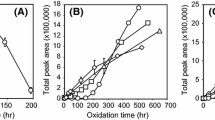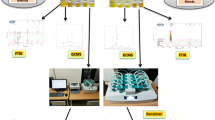Abstract
The lipid profile, in vitro digestion and oxidative stability of mutton bird oil were investigated. Wax ester, triacylglycerol and sterol were the major lipids present as determined using capillary chromatography with flame ionisation detector (Iatroscan). Fatty acid analysis by gas chromatography (GC) showed that wax esters had a higher total omega-3 fatty acids content including EPA, DPA and DHA than TAGs (31 % and 24 %, respectively). In TAGs, 13C nuclear magnetic resonance (NMR) data showed that EPA was statistically positioned at sn-1,3 and sn-2, while DHA was preferentially at sn-2. In vitro digestion using porcine pancreatic lipase resulted in 75 % of TAG and 10 % wax ester hydrolysis in 120 min. As reflected in the measured conjugated dienes (CD) and thiobarbituric acid reactive substances (TBARS) values during accelerated oxidation at 60 °C for 5 days, the oil was relatively stable against oxidation considering its high omega-3 content.




Similar content being viewed by others

References
Ackman RG (2002) The gas chromatograph in practical analyses of common and uncommon fatty acids for the 21st century. Anal Chim Acta 465:175–192
Akanbi TO, Barrow CJ (2014) Lipase-catalysed incorporation of EPA into emu oil: formation and characterisation of new structured lipids. J Funct Foods. doi:10.1016/j.jff.2014.11.010
Akanbi TO, Adcock JL, Barrow CJ (2013) Selective concentration of EPA and DHA using thermomyces lanuginosus lipase is due to fatty acid selectivity and not regioselectivity. Food Chem 138:615–620
Akanbi TO, Sinclair AJ, Barrow CJ (2014) Pancreatic lipase selectively hydrolyses DPA over EPA and DHA due to location of double bonds in the fatty acid rather than regioselectivity. Food Chem 160:61–66
Anderson A (1996) Origins of procellariidae hunting in the southwest Pacific. Int J Osteoarchaeol 6:403–410
Chaijan M, Benjakul S, Visessanguan W, Faustman C (2006) Changes of lipids in sardine (sardinella gibbosa) muscle during iced storage. Food Chem 99:83–91
Christensen M, Lund S, Simonsen L, Hass U, Simonsen S, Høy C-E (1998) Dietary structured triacylglycerols containing docosahexaenoic acid given from birth affect visual and auditory performance and tissue fatty acid profiles of rats. J Nutr 128:1011–1017
Conn P, Lambert C, Land EJ, Schalch W, Truscott T (1992) Carotene-oxygen radical interactions. Free Radic Res 16(6):401–408
Connan M, Mayzaud P, Boutoute M, Weimerskirch H, Cherel Y (2005) Lipid composition of stomach oil in a procellariiform seabird puffinus tenuirostris: implications for food web studies. Mar Ecol Prog Ser 290:277–290
Dunstan GA, Sinclair AJ, O'Dea K, Naughton JM (1988) The lipid content and fatty acid composition of various marine species from southern Australian coastal waters. Comp Biochem Physiol B 91:165–169
Einoder LD, Page B, Goldsworthy SD (2013) Feeding strategies of the short-tailed shearwater vary by year and sea-surface temperature but do not affect breeding success. Condor 115:777–787
Fernandes CE, MAdS V, de Almeida Ribeiro M, Sarubbo LA, SAC A (2014) Nutritional and lipid profiles in marine fish species from Brazil. Food Chem 160:67–71
Gorreta F, Bernasconi R, Galliani G, Salmona M, Tacconi M, Bianchi R (2002) Wax esters of n-3 polyunsaturated fatty acids: a new stable formulation as a potential food supplement. 1-digestion and absorption in rats. LWT Food Sci Technol 35:458–465
Guillén MD, Ruiz A, Cabo N (2004) Study of the oxidative degradation of farmed salmon lipids by means of Fourier transform infrared spectroscopy. Influ Salting J Sci Food Agr 84:1528–1534
Hamam F, Shahidi F (2004) Synthesis of structured lipids via acidolysis of docosahexaenoic acid single cell oil (DHASCO) with capric acid. J Sci Food Agr 52:2900–2906
Hargrove JL, Greenspan P, Hartle DK (2004) Nutritional significance and metabolism of very long chain fatty alcohols and acids from dietary waxes. Exp Bio Med 229:215–226
Hidalgo A, Brandolini A (2008) Kinetics of carotenoids degradation during the storage of einkorn (triticum monococcum L. ssp. Monococcum) and bread wheat (Triticum aestivum L. ssp. Aestivum) flours. J Agric Food Chem 56:11300–11305
Ikeda I, Yoshida H, Tomooka M, Yosef A, Imaizumi K, Tsuji H, Seto A (1998) Effects of long-term feeding of marine oils with different positional distribution of eicosapentaenoic and docosahexaenoic acids on lipid metabolism, eicosanoid production, and platelet aggregation in hypercholesterolemic rats. Lipids 33:897–904
Kralovec JA, Wang W, Barrow CJ (2010) Production of omega-3 triacylglycerol concentrates using a new food grade immobilized Candida antarctica lipase B. Aust J Chem 63:922–928
Lindström MB, Sternby B, Borgström B (1988) Concerted action of human carboxyl ester lipase and pancreatic lipase during lipid digestion in vitro: importance of the physicochemical state of the substrate. Biochim Biophys Acta, Lipids Lipid Metab 959:178–184
Logani M, Davies R (1980) Lipid oxidation: biologic effects and antioxidants—a review. Lipids 15:485–495
Miller MR, Perry NB, Burgess EJ, Marshall SN (2011) Regiospecific analyses of triacylglycerols of hoki (macruronus novaezelandiae) and greenshell™ mussel (perna canaliculus). J Am Oil Chem Soc 88:509–516
Nelson GJ, Ackman RG (1988) Absorption and transport of fat in mammals with emphasis on n − 3 polyunsaturated fatty acids. Lipids 23:1005–1014
Palozza P, Krinsky NI (1991) The inhibition of radical-initiated peroxidation of microsomal lipids by both α-tocopherol and β-carotene. Free Radic Biol Med 11:407–414
Sacchi R, Medina I, Aubourg SP, Giudicianni I, Paolillo L, Addeo F (1993) Quantitative high-resolution 13C NMR analysis of lipids extracted from the white muscle of Atlantic tuna (thunnus alalunga). J Agric Food Chem 41:1247–1253
Skira I. (1990). Human exploitation of the short-tailed shearwater (Puffinus tenuirostris). In Papers and Proceedings of the Royal Society of Tasmania (77–90)
Standal IB, Axelson DE, Aursand M (2009) Differentiation of fish oils according to species by 13C-NMR regiospecific analyses of triacyglycerols. J Am Oil Chem Soc 86:401–407
Virtue P, Johannes R, Nichols P, Young J (1995) Biochemical composition of nyctiphanes australis and its possible use as an aquaculture feed source: lipids, pigments and fluoride content. Mar Biol 122:121–128
Vongsvivut J, Miller MR, McNaughton D, Heraud P, Barrow CJ (2014) Rapid discrimination and determination of polyunsaturated fatty acid composition in marine oils by FTIR spectroscopy and multivariate data analysis. Food Bioprocess Technol 7:2410–2422
Warham J. (1977). The incidence, functions and ecological significance of petrel stomach oils. In Proceedings of the New Zealand Ecological Society (84–93).
Weimerskirch H, Cherel Y (1998) Feeding ecology of short-tailed shearwaters: breeding in Tasmania and foraging in the Antarctic? Mar Ecol Prog Ser 167:261–274
Wijesundera C, Ceccato C, Watkins P, Fagan P, Fraser B, Thienthong N, Perlmutter P (2008) Docosahexaenoic acid is more stable to oxidation when located at the sn-2 position of triacylglycerol compared to sn-1 (3). J Am Oil Chem Soc 85:543–548
Wishart M, Andrews P, Nichols R, Blevins G, Logsdon C, Williams J (1993) Identification and cloning of GP-3 from rat pancreatic acinar zymogen granules as a glycosylated membrane-associated lipase. J Biol Chem 268:10303–10311
Woodward D, Riley M, Buick D, Nichols D, Nichols P (1995) Nutritional analysis of the flesh and oil of yolla, the Tasmanian mutton bird puffinus tenuirostris: a useful source of omega-3 polyunsaturated fatty acids. Aust J Nutr Diet 52:87–91
Yang L, Kuksis A, Myher J (1990a) Intestinal absorption of menhaden and rapeseed oils and their fatty acid methyl and ethyl esters in the rat. Biochem Cell Biol 68:480–491
Yang L, Kuksis A, Myher J (1990b) Lipolysis of menhaden oil triacylglycerols and the corresponding fatty acid alkyl esters by pancreatic lipase in vitro: a reexamination. J Lipid Res 31:137–147
Acknowledgments
The authors acknowledge Furneaux oil, Flinders Island, Tasmania for providing the mutton bird oil used in this study. The authors acknowledge the Centre for Chemistry and Biotechnology, Deakin University for funding.
Author information
Authors and Affiliations
Corresponding author
Rights and permissions
About this article
Cite this article
Akanbi, T.O., Barrow, C.J. Lipid profiles, in vitro digestion and oxidative stability of mutton bird oil. J Food Sci Technol 53, 1230–1237 (2016). https://doi.org/10.1007/s13197-015-2106-7
Revised:
Accepted:
Published:
Issue Date:
DOI: https://doi.org/10.1007/s13197-015-2106-7



